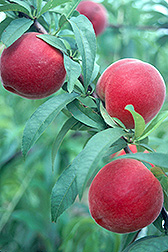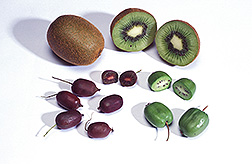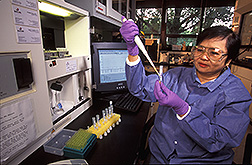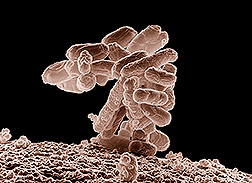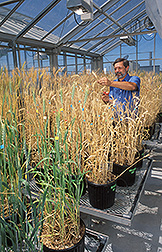| April 2005 |
Low B12 Signals Men’s Poor Bone Health
A newly reported study links vitamin B12 deficiency with low bone-mineral density in men, and it confirms similar, previously reported findings in women.
ARS-funded researchers at the Jean Mayer USDA Human Nutrition Research Center on Aging, Boston, Mass., based these findings on their investigation of vitamin B12 blood levels and bone health indicators of 2,576 men and women, age 30 to 87 (Journal of Bone and Mineral Research, volume 20, pages 152-158). Animal-protein foods such as fish, beef, pork, milk and cheese are good sources of vitamin B12.
Contact: Katherine L. Tucker, (617) 556-3351; ARS Jean Mayer USDA Human Nutrition Research Center on Aging at Tufts University, Boston, MA.
Meat or Soy Protein: Neither Harms Volunteers' Bones
Meals with protein from meat or soy didn't harm the bone health of 13 postmenopausal volunteers in an ARS study. Scientists at ARS' Grand Forks (N.D.) Human Nutrition Research Center and colleagues at the ARS Arkansas Children's Nutrition Center also determined that the volunteers, age 52 to 69, absorbed and retained calcium equally well from regimens containing meat or meat plus soy protein. Their findings appeared in the January 2005 issue of the Journal of Clinical Endocrinology & Metabolism (volume 90, pages 181-189).
By the study's end, volunteers had completed each of two different seven-week stints. The regimens featured well-balanced meals that provided, among other nutrients, average amounts of protein primarily from animal sources, or--on the other regimen--from soy and meat.
Researchers found no significant difference in volunteers' bone health after either regimen. That's contrary to a popularly held theory that high-meat regimens may leach calcium from bones. It also suggests that soy's phytate doesn't interfere with the body's ability to absorb minerals.
Contact: Janet R. Hunt, (701) 795-8328; USDA-ARS Grand Forks Human Nutrition Research Center, Grand Forks, N.D.
Bone-Health Investigations Span a Spectrum of Ages
Bone-health studies of preteens, young women and postmenopausal volunteers are revealing more details about the roles of nutrition and exercise in preventing osteoporosis.
Iowa State University researchers are collaborating with scientists from the ARS Western Human Nutrition Research Center, Davis, Calif., in a new study of soy supplements' effects on the bone health of more than 200 healthy, postmenopausal volunteers. Preliminary results are expected next year.
An earlier investigation, reported in 2003 and led by Stanford University scientists in collaboration with ARS and University of California at Berkeley researchers, looked at the eating, health and exercise histories of women volunteers in their preteens through early 20s.
The findings confirmed those of other studies, done elsewhere, and underscored the importance of exercising and eating calcium-rich foods. Volunteers who exercised more in their preteen years and ate a daily average of more than 1,000 mg of calcium had better bone health when they reached their 20s than did volunteers who exercised less and consumed less calcium (American Journal of Clinical Nutrition, volume 77, pages 495-503).
Contact: Marta D. Van Loan, (530) 752-4160; USDA-ARS Western Human Nutrition Research Center, Davis, CA.
Can Citrus Limonoids Lower Cholesterol?
ARS studies give us even more to like about oranges, already America's favorite fruit. Oranges and some other kinds of citrus are rich in limonoids, which have been shown in lab tests with animals or human cells to help fight certain cancers.
Scientists based at the ARS Western Regional Research Center, Albany, Calif., demonstrated--several years ago--that each time we eat citrus fruit or drink citrus juices, our bodies readily access a limonoid called limonin (Journal of Agricultural and Food Chemistry, volume 51, pages 4156-4161). New ARS study will look at limonin's cholesterol-lowering effects in healthy volunteers, a first-of-its-kind investigation.
Contact: Gary D. Manners, (510) 559-5813; USDA-ARS Western Regional Research Center, Albany, CA.
Sweet and Splendid: Gulfking and Gulfcrest Peaches
Gulfking and Gulfcrest, two delicious new peaches from ARS plant breeders in Byron, Ga., and their University of Florida and University of Georgia colleagues, may begin showing up in the produce section of some supermarkets this year.
Intended for growing in the southeastern states, both of these peaches have sweet, firm flesh that does not brown easily when bumped or cut.
Gulfking typically ripens in early May; Gulfcrest is ready to pick from early- to mid-May.
Contact: Thomas G. Beckman, (478) 956-6436; USDA-ARS Southeastern Fruit and Tree Nut Research Laboratory, Byron, GA.
Grape-Sized Kiwifruit: Longer Season Ahead?
|
|
Kiwifruit that's sold in supermarkets coast to coast has a lesser-known, grape-sized cousin called hardy kiwifruit. The mini-kiwi is fuzzless, but inside it has the same sweet-tart, green flesh and tiny, black seeds as its egg-sized relative.
The leading kind of small kiwifruit that's grown in the United States ripens in mid-September and can be stored for only a few weeks. That's why scientists working at the ARS National Clonal Germplasm Repository and at the ARS Horticultural Crops Research Laboratory, both in Corvallis, Ore., are developing a slightly larger, earlier-ripening version of the junior-sized kiwifruit.
Contact: Kim E. Hummer, (541) 738 4201; USDA-ARS National Clonal Germplasm Repository, Corvallis, OR.
|
|
New for You: Charleston Blackeye and Baby Cream
Southernpeas, rich in protein, are primarily sold canned or frozen for serving with spicy rice, adding to soups or enjoying in other entrees or side dishes. Two outstanding new southernpeas from ARS scientists at the U.S. Vegetable Laboratory, Charleston, S.C., are drought-resistant, will thrive on poor soils and are well-suited to growing in southeastern states.
Charleston Blackeye resists attack by root-knot nematodes and is intended for fresh-market growers or home gardeners who like the taste of traditional, fresh-shell blackeye peas. Baby Cream yields small, delicate, succulent peas with a milder, less starchy flavor.
Contact: Richard L. Fery, (843) 402-5300, ext. 5301, or Judy A. Thies, (843) 402-5300, ext. 5317; USDA-ARS U.S. Vegetable Laboratory, Charleston, S.C.
Shellfish Studies Uncover Suspicious Protein
A novel protein with the tongue-twisting name of phosphoglucose isomerase may raise the likelihood of getting sick after eating contaminated shellfish.
Scientists at the ARS Microbial Safety of Aquaculture Products Center of Excellence, Dover, Del., and their colleagues discovered that this protein occurs in Vibrio vulnificus. Then they provided many new details about the protein's activity, and showed that it occurs in virtually all of the Vibrio species they tested.
The scientists note that the research has led to new methods for rapidly detecting the infectious bacteria. New methods to kill the microbes may follow.
Contact: Gary P. Richards, (302) 857-6419; USDA-ARS Microbial Safety of Aquaculture Products Center of Excellence, Dover, DE.
Supersensor May Enhance Safety of Ham, Eggs, Milk
A new approach to detecting food contaminants should help industry and government food-safety inspectors keep foods safe for us to enjoy. ARS scientists at the Eastern Regional Research Center, Wyndmoor, Pa., have partially automated an optical method called surface plasmon resonance, or SPR, for inspecting foods such as ham, whole liquid eggs and milk.
They've shown that the technology, already used at some food processing plants to monitor other contaminants, can detect and measure the quantity of gastroenteritis-causing toxins A and B of Staphylococcus.
Conventional heating and other food-processing procedures can kill certain pathogens but not necessarily zap their heat-resistant toxins, the scientists note. Their findings appear in the Journal of Rapid Methods and Automation in Microbiology, volume 2, pages 38-54.
Contact: Marjorie B. Medina, (215) 233-6436; USDA-ARS Eastern Regional Research Center, Wyndmoor, PA.
Foodborne Pathogens’ Antibiotic Resistance Scrutinized
Foodborne pathogens like Campylobacter can develop resistance to antibiotic drugs used in raising livestock. So ARS scientists in Athens, Ga., are determining and documenting the microbes' characteristics in healthy or sick farm animals.
The resulting database--the nation’s largest about antibiotic resistance of Campylobacter, Enterococcus, Escherichia coli and Salmonella--may help researchers detect resistance patterns, a formidable challenge. For instance, each of the more than 2,400 Salmonella types appears to develop resistance at a different rate.
Contact: Paula Fedorka-Cray, (706) 546 3305; USDA-ARS Richard B. Russell Research Center, Athens, GA.
Protein Profilers’ Aim: Superior Flours, Superb Breads
Your favorite breads may owe much to the baker's skill and the top-quality wheat flour used in making the delectable loaves. In turn, the excellence of wheat flours is due, in large part, to the work of hundreds of different proteins in the wheat kernels from which flour is milled.
By taking a closer look at these proteins, ARS scientists at the Western Regional Research Center hope to create even better wheat flours for tomorrow. Some of these proteins' jobs range from storing carbohydrates to protecting kernels against insects.
Though similar research has been done at other labs to identify proteins and their functions in wheat, barley and alfalfa, the California investigators are probably the first to delve this deeply into the roles and changing ratios of wheat's lesser-known wheat-kernel proteins. A recent article in Proteomics (volume 5, pages 1594-1611) has details.
Contact: William J. Hurkman, (510) 559-5720; USDA-ARS Western Regional Research Center, Albany, CA.
Walnuts’ Secret Defender: Gallic Acid
Walnuts--like several other foods--are vulnerable to Aspergillus flavus and A. parasiticus fungi that produce aflatoxin. Inspections ensure that walnuts are free of harmful levels of aflatoxin, which is thought to be a carcinogen.
Earlier investigations by ARS Western Regional Research Center scientists and university co-researchers determined that high levels of a natural compound, gallic acid, prevent Aspergillus from making aflatoxin in Tulare, one of the many kinds of English-type walnuts grown in the United States today (Journal of Food Science, volume 68, pages 619-622).
Gallic acid is a component of the tannins in the pellicle, the thin skin that surrounds the nutmeat. Now the scientists intend to solve the mystery of exactly how gallic acid thwarts Aspergillus’ aflatoxin production.
Contact: Russell J. Molyneux, (510) 559-5812; USDA-ARS Western Regional Research Center, Albany, CA.
|
The United States Department of Agriculture (USDA) prohibits discrimination in all its programs and activities on the basis of race, color, national origin, gender, religion, age, disability, political beliefs, sexual orientation, and marital or family status. (Not all prohibited bases apply to all programs.) Persons with disabilities who require alternative means for communication of program information (Braille, large print, audiotape, etc.) should contact USDA's TARGET Center at (202) 720-2600 (voice and TDD). To file a complaint of discrimination, write USDA, Director, Office of Civil Rights, Room 326-W, Whitten Building, 14th and Independence Ave., SW, Washington, DC 20250-9410 or call (202) 720-5964 (voice or TDD). USDA is an equal opportunity provider and employer. |






